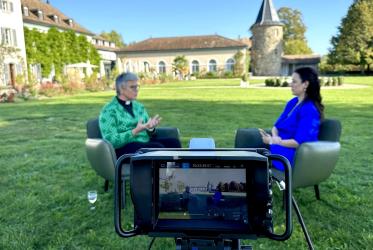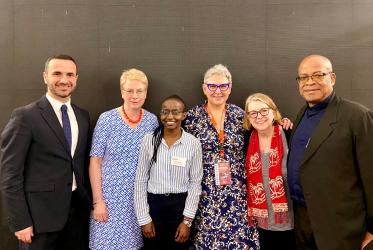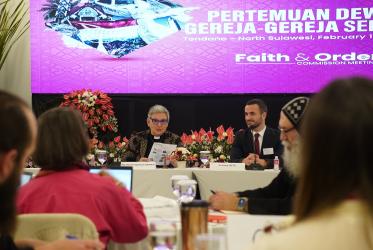Introduction
1. Greetings
From the Faith and Order Commission of the World Council of Churches, to the churches of the world: greetings in the name of Christ Jesus our Saviour. The Faith and Order Plenary Commission has concluded its meeting in Moshi, Tanzania, at the foot of Mount Kilimanjaro (August 10-24, 1996). It wishes to share with the churches the content and future direction of its work, together with reflections on how the churches may be encouraged in their work towards full visible unity among themselves, the task in which Faith and Order has been engaged on behalf of the churches for nearly 70 years. The Faith and Order Plenary Commission is made up of 120 people drawn from among the member churches of the WCC, and from the Roman Catholic Church, Pentecostals, and Seventh Day Adventists. In our meeting we have sought to become a community of prayer and theological reflection, attempting to model a unity in diversity in our life together.
Context
2. Africa: the context of our meeting
It was highly appropriate that the Plenary Commission met in Africa, and the setting has influenced our lives and our work. Christianity in Africa is in many places jubilant, musical, flourishing with young life; the church is growing faster here than on any other continent, growing every day in number and in spirit. Christians here are also, in some places, troubled minorities. In Rwanda and Burundi, next door to our host country, complex ethnic, historic, political and demonic forces, not to mention outside interests exploiting the situation, have combined to produce a horrific scene in which neighbours slay neighbours, Christians slay Christians, while the international community appears helpless. We pray that the churches of the region may be able to do all that is possible to bring the bloodshed to an end and to work for a peaceful solution for the reconciling of peoples in the Spirit of Jesus Christ, who "is our peace" (Eph. 2: 14).
3. Utu, an African expression of koinonia
Here in Tanzania, which has taken concrete steps in helping its neighbours in conflict, both the enthusiasm of the people of God and their material poverty stand as reminders that the gospel's promise of life abundant is not what the world understands by success. The African understanding of community, of extended family, of Utu, is a profound image of koinonia, and is a gift to be received by those who have been tempted by the spirit of egocentrism. We have also been powerfully reminded that, in contrast to Utu, there are forces and structures of greed at work in this continent which impoverish whole nations and peoples, and which allow practices of environmental destruction to continue so long as they are far from the homes of those who profit. In Tanzania we are vividly called back to the truth that faith in Jesus Christ brings freedom, wholeness and salvation, and commits us to work for the building of a community of love and reconciliation throughout the world.
4. For the unity of all
At the beginning of our meeting, we were honoured in being welcomed by the President of Tanzania, His Excellency Benjamin William Mkapa. He reminded us that the search for unity is not just about the unity of the church, but about "the unity and universality of humankind in its entirety". Here in Africa, where the extremes of the division of rich and poor are seen in such contrast, where such beauty in creation and such exploitation and despoliation both abound, we are reminded that the church's calling to proclaim the gospel on every continent and island is always to be accompanied by the requirement to live by the values of the gospel in every aspect of our life together, and to call the world to a gospel quality of life for all. As one of our members observed, one cannot have true koinonia, true unity and communion, among unequal partners.
5. Partnership for mission
We invite the churches who are engaged in mission in Africa and elsewhere to cooperate with, and take their cues from, the churches already flourishing on the local soil. We invite the churches to model partnership in mission, allowing church to speak to church in prophetic ways which call us all back to the values of the gospel. We remind all churches that St. Paul invited the diverse Christian communities of his time to share their resources, both material and spiritual. Churches have opportunities, as very few institutions do, to remind the world that we are one world, that the indebtedness of one impoverishes us all, that the greed of one corrupts us all. The church has a divine mandate to be and to be seen to be a community of love, a community of blessing.
Unity and Diversity
6. Many voices, one faith
The Faith and Order movement is itself learning to listen to and speak with more and more voices, from many different contexts. The voices of African Christians here have spoken of their experience of disunity sown in families by competing denominations, and have shared new articulations of theology forged in persecution and oppression, in extreme poverty and in isolation. They have spoken through cultures which are ancient and yet new in their Christian expression. We are reminded that those committed to unity need to find ways of speaking, understanding and sharing across the human boundaries of regions, cultures, languages, race and gender, as well as among the families of Christian churches. We invite all our churches to learn "to listen to what the Spirit is saying to the churches", (Rev. 2:7) through their own languages.
7. Called to be one
Diversity is a joyous gift, yet it needs to "be united in the same mind and the same purpose" (I Cor. 1:10) by the God who is three and yet one. Diversity today can and does raise new and difficult questions of theology and ethics which the churches need to find ways to address together, within and among themselves. Faith and Order, and the churches, are searching for models and methods for achieving unity without uniformity, diversity without division. If the churches engage wholeheartedly in their quest for unity in diversity, they might provide models of hope for a divided humanity.
The Ecumenical Movement
8. A century of ecumenism
The century which is drawing to a close has been called the "ecumenical century". As we begin to reflect on what this period of growth together as churches has meant, it is important to recall that the modern ecumenical movement was initiated by Christians who had learned in their missionary experience that a divided Church cannot effectively preach and advance the one gospel. As in so many other parts of the world, the missionary movement brought the great blessing of the Christian message to Africa, where it has been received with joy, in spite of the hurt which the human failings of its agents have at times caused. The ecumenical movement which was born from the missionary movement has been transformed from an alliance of northern churches into a truly global community. It has become a process of mutual understanding among churches, among women and men, among people from all the diverse regions of the planet. The ecumenical agenda now includes more than the search for reuniting divided church communions, though that, in itself, is the central goal for which we are still striving.
9. Common understanding and vision of the WCC
At its meeting, Faith and Order was conscious of the process currently underway in the World Council of Churches, the "Common Understanding and Vision Process", which has sought afresh to express the intention of the churches in working together in a World Council of Churches. The meeting welcomed Dr Konrad Raiser, General Secretary of the WCC, who expressed the hope that the Assembly in Harare in 1998, which will mark the 50th anniversary of the founding of the WCC, would re-affirm that "the primary purpose of the World Council of Churches is for the churches together to call each other to the goal of visible unity in one faith and in one eucharistic fellowship expressed in worship and in common life, and to advance towards that unity in order that the world may believe." Faith and Order believes that this purpose is, indeed, the heartbeat of the World Council of Churches.
The Work of Faith and Order
10. The harvest of Faith and Order
This is the first full-length meeting of the Plenary Commission since the Canberra Assembly of the World Council of Churches, which adopted the Canberra Statement on unity: "The Koinonia of the Church: Gift and Calling". It is also the first meeting since the Fifth World Conference on Faith and Order held in Santiago de Compostela, which "harvested" the work of Faith and Order over the past 30 years. Santiago affirmed the many ecumenical achievements in bilateral and multilateral dialogues among our Christian traditions, invited the churches to make concrete the convergences identified in the Baptism, Eucharist and Ministry study, and underlined the importance of confessing together the one apostolic faith as well as sharing in mission and service. It stressed that "there is no turning back either from the goal of visible unity or from the single ecumenical movement that unites concern for the unity of the church and concern for engagement in the struggles of the world". (Message, Santiago, para. 3)
11. A time for discernment
As the 21st century dawns, much of the harvest of this century's ecumenical endeavours is still waiting to be turned into bread for the life of the churches and the world. Many expressions and instruments of the ecumenical movement, including the World Council of Churches, are struggling to be faithful to their mandate in a time of new challenges. This is a time for discernment, a time which many are calling a crisis, even a spiritual crisis: the churches and the world face new and diverse threats to unity; the enthusiasm of ecumenical discovery has turned more measured and sober; financial resources are scarcer (or given elsewhere). Faith and Order is at a crossroads. It has offered much ecumenical convergence to the churches, but knows that there is much more yet to be done, both in making convergence concrete and in trying to achieve convergence on many difficult issues. Do we have the courage and the will to address together deep and complex questions related to authority and interpretation which not only separate churches from one another, but which are also being debated within churches?
12. Our study projects
Faith and Order, in this context, has been engaged in some specific studies building on the foundation of BEM, which are all intended, under grace, to contribute to the task of building for unity:
a) ecclesiology: the ongoing study on the nature and purpose of the church will be asked to consider issues of conciliarity, primacy and the ministry of unity, oversight, authority, laity, the ministries of women, reconciliation of memories, the four marks of the church, the visible and invisible nature of the church, the trinity as source of the koinonia of the church, as well as the insights and challenges of the other major studies
b) ecumenical hermeneutics: a study asked for by Santiago, which focuses on the way in which texts, symbols and practices of the various Christian churches may be interpreted, communicated, and received accurately by each other as they engage in dialogue
c) ecclesiology and ethics: this on-going work on the relationship between the nature of the church and its ethical witness in and for the sake of the world will be asked to include work on the unity of the church in relation to ethnic identity and nationalism
d) worship: work on worship in the search for unity will continue, with consideration of the question of unity and diversity in worship and its relationship to the search for visible unity in the church; a consultation on Baptism is planned for January, 1997, to address baptismal ordo, inculturation of baptism, and ethical and ecclesiological implications of baptism
e) apostolic faith: the study guide "Towards Sharing the One Faith" was warmly received and will be sent to the churches. It is intended to engage Christians everywhere in the issues addressed in the important study "Confessing the One Faith", which was sent to the churches in 1990; the study guide offers a flexible resource for use as locally appropriate.
13. Reception
Agreed statements are wonderful gifts, born of the Spirit who calls us together in dialogue and mutual learning, but they will pile up in libraries and be of little use in achieving the goal of full visible unity unless the churches make them their own. The texts, but also the spirit in which ecumenical texts are written, are offered for reception and action by the churches. We have learned that such reception will be furthered by Christians from different contexts and regions engaging in a dynamic process of building unity and mutual understanding in and among local churches. We call on churches to find ways to commit themselves concretely, not only to agreed statements (most of which have still to be received) but also to living out the implications of agreement in the faith. Reception will involve being much more open to receiving one another, as persons and as churches.
14. Some specific steps
There are many steps toward unity which the churches are taking, and we invite them to learn from one another's rich experience as they take further steps. The Canberra Statement on unity included a number of concrete proposals, all of which are achievable if the will is there. In addition, this Plenary Commission has been reminded of additional possibilities: youth exchanges among churches and regions; undertaking journeys of pilgrimage together; publicly asking for forgiveness from and forgiving one another; using the Apostolic Faith Study Guide ecumenically; finding more ways of worshipping together more often, including a broader observance of the Week of Prayer for Christian Unity; finding ways of sharing their ecumenical learnings and insights.
Conclusion
15. One ecumenical movement
There is one ecumenical movement, a movement born of the Spirit of Christ, the Spirit of reconciling love. The Plenary Commission of Faith and Order affirms, and invites all churches to affirm, that the church of God, one, holy, catholic and apostolic, is evangelical, ecumenical, biblical, sacramental, orthodox, charismatic, diverse yet united in the koinonia of the divine Trinity. It is our hope that all churches may find fresh ways to enable all believers to tell their own stories, to sing their own songs of praise, to share their own experience of the Spirit, and to claim them all as our common heritage in the expression of the one faith. It is our prayer that all Christians everywhere may begin the new century, the new millennium, in a spirit of humility, repentance, and open-hearted discovery, ready to be led by the Spirit, together where God wills, and, if God wills, into a new life which will bring gladness and hope to the whole earth.
16. Conclusion
We also gladly proclaim that, although we invite all to try their best to reconcile their divisions, to heal the hurts of the past, to learn from many more contexts, to seek together the truth of the gospel, and to live as true brothers and sisters with each other around the globe, we will not achieve the visible unity of the church by our own efforts. The church is God's church, as the world is God's world, and to that God we give glory and praise and thanksgiving, in a song new and old, the song of all creatures under heaven: to the Holy Trinity be glory, three in one and one in three, diversity perfectly united, and we pray:
Mungu abariki watu wote, awape uhuru na umoja!
("May God grant everyone freedom and unity", based on the Tanzanian national anthem)



